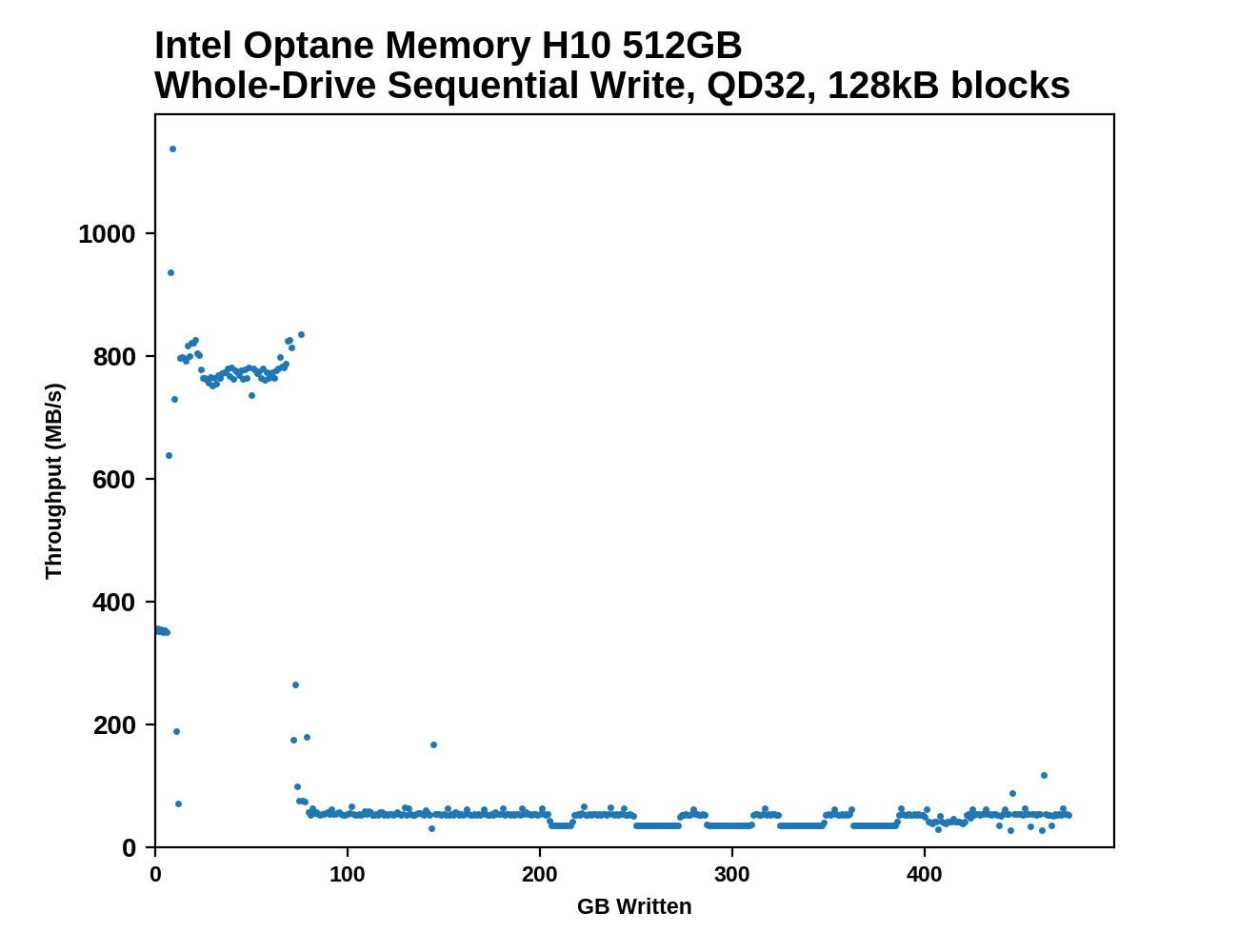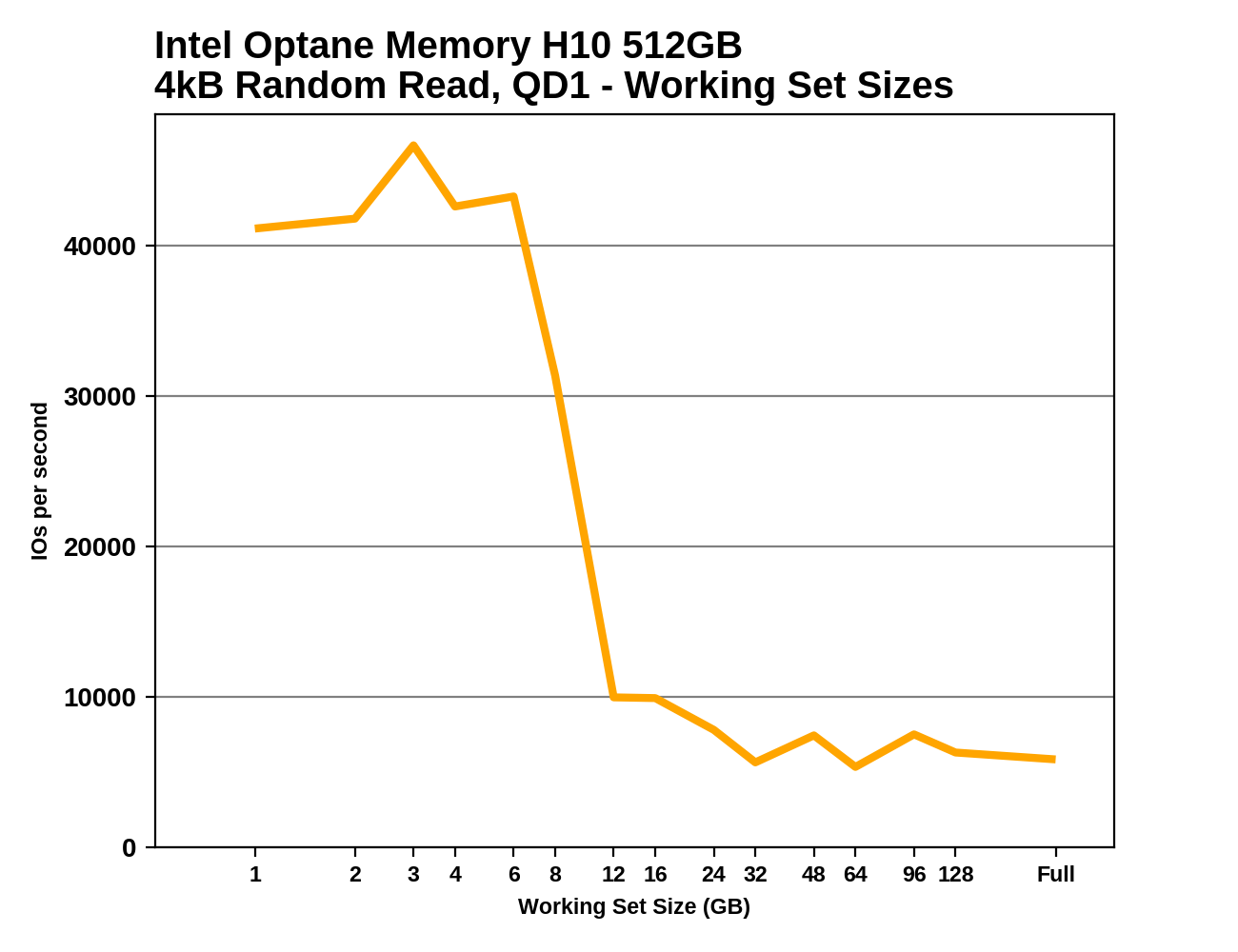The Intel Optane Memory H10 Review: QLC and Optane In One SSD
by Billy Tallis on April 22, 2019 11:50 AM ESTWhole-Drive Fill
This test starts with a freshly-erased drive and fills it with 128kB sequential writes at queue depth 32, recording the write speed for each 1GB segment. This test is not representative of any ordinary client/consumer usage pattern, but it does allow us to observe transitions in the drive's behavior as it fills up. This can allow us to estimate the size of any SLC write cache, and get a sense for how much performance remains on the rare occasions where real-world usage keeps writing data after filling the cache.
 |
|||||||||
During a sustained write, the Optane cache on the Intel Optane Memory H10 doesn't change the situation much from how the QLC-only Intel 660p behaves—the Optane cache on its own is only good for about 350MB/s. The SLC write cache on the NAND side is a more important factor that helps sustain high write speed far beyond the 32GB size of the Optane cache. But eventually, all the caches fill up and the very slow write speed of raw QLC takes over.
 |
|||||||||
| Average Throughput for last 16 GB | Overall Average Throughput | ||||||||
The overall average write speed when completely filling the Optane Memory H10 is unsurprisingly lower than any of the other drives in this batch. The 1TB Intel 660p was already a bit slower than a 7200RPM hard drive, and our H10 sample has half as much QLC to work with.
Working Set Size
 |
|||||||||
The Optane cache on the H10 is 32GB, but when testing random reads it appears to only be good for about 6-8GB working sets before the cache starts thrashing and performance drops down to roughly what a QLC-only drive can offer. It appears that Intel may be reserving a large portion of the Optane cache to serve as a write buffer, and this might be detrimental to the most read-intensive workloads.










60 Comments
View All Comments
Valantar - Tuesday, April 23, 2019 - link
"Why hamper it with a slower bus?": cost. This is a low-end product, not a high-end one. The 970 EVO can at best be called "midrange" (though it keeps up with the high end for performance in a lot of cases). Intel doesn't yet have a monolithic controller that can work with both NAND and Optane, so this is (as the review clearly states) two devices on one PCB. The use case is making a cheap but fast OEM drive, where caching to the Optane part _can_ result in noticeable performance increases for everyday consumer workloads, but is unlikely to matter in any kind of stress test. The problem is that adding Optane drives up prices, meaning that this doesn't compete against QLC drives (which it would beat in terms of user experience) but also TLC drives which would likely be faster in all but the most cache-friendly, bursty workloads.I see this kind of concept as the "killer app" for Optane outside of datacenters and high-end workstations, but this implementation is nonsense due to the lack of a suitable controller. If the drive had a single controller with an x4 interface, replaced the DRAM buffer with a sizeable Optane cache, and came in QLC-like capacities, it would be _amazing_. Great capacity, great low-QD speeds (for anything cached), great price. As it stands, it's ... meh.
cb88 - Friday, May 17, 2019 - link
Therein lies the BS... Optane cannot compete as a low end product as it is too expensive.. so they should have settled for being the best premium product with 4x PCIe... probably even maxing out PCIe 4.0 easily once it launches.CheapSushi - Wednesday, April 24, 2019 - link
I think you're mixing up why it would be faster. The lanes are the easier part. It's inherently faster. But you can't magically make x2 PCIe lanes push more bandwidth than x4 PCIe lanes on the same standard (3.0 for example).twotwotwo - Monday, April 22, 2019 - link
Prices not announced, so they can still make it cheaper.Seems like a tricky situation unless it's priced way below anything that performs similarly though. Faster options on one side and really cheap drives that are plenty for mainstream use on the other.
CaedenV - Monday, April 22, 2019 - link
lol cheaper? All of the parts of a traditional SSD, *plus* all of the added R&D, parts, and software for the Optane half of the drive?I will be impressed if this is only 2x the price of a Sammy... and still slower.
DanNeely - Monday, April 22, 2019 - link
Ultimately, to scale this I think Intel is going to have to add an on card PCIe switch. With the company currently dominating the market setting prices to fleece enterprise customers, I suspect that means they'll need to design something in house. PCIe4 will help some, but normal drives will get faster too.kpb321 - Monday, April 22, 2019 - link
I don't think that would end up working out well. As the article mentions PCI-E switches tend to be power hungry which wouldn't work well and would add yet another part to the drive and push the BOM up even higher. For this to work you'd need to deliver TLC level performance or better but at a lower cost. Ultimately the only way I can see that working would be moving to a single integrated controller. From a cost perspective eliminating the DRAM buffer by using a combination of the Optane memory and HBM should probably work. This would probably push it into a largely or completely hardware managed solution and would improve compatibility and eliminate the issues with the PCI-E bifrication and bottlenecks.ksec - Monday, April 22, 2019 - link
Yes, I think we will need a Single Controller to see its true potential and if it has a market fit.Cause right now I am not seeing any real benefits or advantage of using this compared to decent M.2 SSD.
Kevin G - Monday, April 22, 2019 - link
What Intel needs to do for this to really take off is to have a combo NAND + Optane controller capable of handling both types natively. This would eliminate the need for a PCIe switch and free up board space on the small M.2 sticks. A win-win scenario if Intel puts forward the development investment.e1jones - Monday, April 22, 2019 - link
A solution for something in search of a problem. And, typical Intel, clearly incompatible with a lot of modern systems, much less older systems. Why do they keep trying to limit the usability of Optane!?In a world where each half was actually accessible, it might be useful for ZFS/NAS apps, where the Optane could be the log or cache and the QLC could be a WORM storage tier.